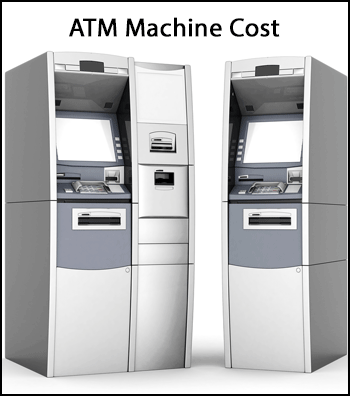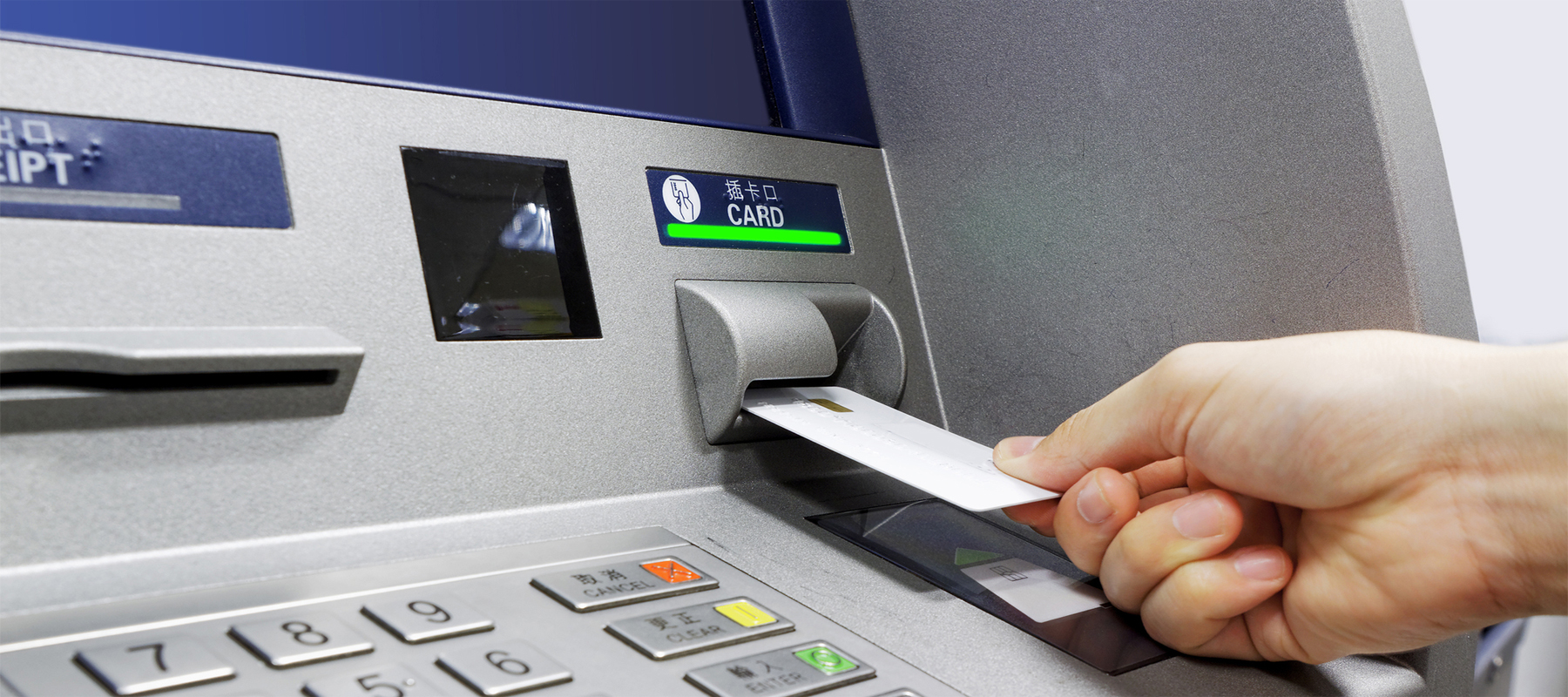ATM Machine Cost Breakdown: What to Expect When Purchasing an ATM Machine
Last Updated: April 24, 2023

Fact Checked By: Ashley Smith
On This Page
CostOwl.com note: Need an atm machine at an affordable price? Fill out the 30 second questionnaire below and our atm machine partners will send you free price quotes.
Summary: ATM Machine Cost #
Buying an ATM will cost between $2,000 and $4,000 on average. Higher end ATM machines that are built into the wall are more expensive and can cost between $5,000 and $10,000. An optional cash loading service runs $40 to $60 per month.

Restaurants, nightclubs, convenience stores, gas stations, and many other locations and businesses can benefit from having an automated teller machine (ATM) on site. Even though more and more purchases are being made with debit cards and newer technologies such as smart phone apps, cash is by no means obsolete. Installing a cash machine could increase profits for your business through ATM fees, eliminating credit card processing fees, and allowing customers to instantly get cash to spend at your location. This buying guide will help you determine whether buying an ATM machine is a good move for your business and how much you can expect to pay for one.
How to Decide if You Need an ATM Machine #
Because a cash machine costs thousands of dollars, it is important to first decide whether you can justify the expense. If your business meets any of the following criteria, you should strongly consider having an ATM bank machine installed.
- Customers routinely ask where the nearest ATM machine is located.
- Hundreds of people walk by your business every day and can see the cash machine itself or a sign for it.
- Your business is dependent upon cash transactions.
- Your business makes numerous credit card transactions for small amounts.
Types of ATM Machines #
Automated teller machines can be divided into the following categories:
- Freestanding ATM: A freestanding ATM machine is a popular choice for a business that has enough floor space (typically two feet by two feet plus enough room for customers to stand). These machines are commonly found in gas stations, convenience stores, and restaurants.
- Countertop ATM: Countertop ATM machines are designed for those businesses that do not have enough space for a freestanding cash machine.
- Built-in ATM: A built-in, or through-the-wall, ATM machine is the type of cash machine commonly found at banks. They are typically more expensive to install, as they require construction work. If your business has heavy after-hours foot traffic, an outdoor, built-in cash machine might be a good choice (but bear in mind increased risks from thieves and the elements).
- Dial-up ATM: Most cash machines use a 56 kbps modem to dial into an ATM processing network and therefore require a dedicated phone line.
- Wireless ATM: Businesses that already have a high-speed internet connection (for a Wi-Fi hotspot or credit card processing, for example) can utilize wireless technology for an ATM machine as well. This eliminates the need for a phone line, speeds up transactions, and provides flexibility for a cash machine's location.
ATM Machine Sample Costs #
If a cash machine sounds like a wise investment for your business, the following information will give you a general understanding of the associated costs.
Generally, ATM machines cost anywhere from around $1,000 up to $25,000 or more.
A freestanding ATM machine costs approximately $3,500 to $7,000 and up.
A built-in/through-the-wall ATM machine costs roughly $5,000 to $10,000 and up.
A used/refurbished ATM machine can be purchased starting at about $500.
An ATM machine without a dispenser and cassette costs around $1,250 to $1,750.
A Triton stand-alone ATM Machine with an 800-note cash drawer, dial combination lock, door sticker, lighted sign and dialup connectivity costs about $2,000 to $2,500.
A freestanding ATM machine with a color LCD, 1,000 note cassette, thermal receipt printer, and dial-up connectivity might cost $3,000 to $4,000.
A built-in/through-the-wall ATM machine with a monochrome LCD, thermal receipt printer, 2,000 note cassette, and wireless capability costs around $6,000 to $9,000.
Customers nationwide report paying an average of $2,000 to $4,000 for an ATM machine.
Additional ATM costs might include:
A phone line ($20 to $40/month)
Cash loading service (optional; roughly $40 to $60 per trip)
An additional cash cassette (approximately $100 to $500)
Replacement receipt paper
ATM vendor fees (if included, these could be around $10 to $20 per month)
How Much Money Can I Make from an ATM? #
There are several factors that are involved in how much money you can gain from installing an ATM. The average surcharge for withdrawal is $3 to $4, but if you own the ATM you can set it to whatever you want (please note that if it's too high, people are much less likely to use your machine).
Check local and state laws and provisions, as some states have a specific maximum transaction fee. The funds from these fees are typically deposited in your business’s account at the end of each month. But the true amount of revenue to be gained from an ATM is not always a simple answer.
You need to consider the amount of times the unit will be used per day, or if you have multiple units, how often each one will be used or the average amount of transactions between the group. ATMs in a retail environment average about six to ten transactions a day, but depending on your area or business that can increase tenfold. Owning and operating a single ATM isn’t likely to make you incredibly rich overnight, but it can increase the amount of daily revenue you receive and increase profits over time.
For example, let’s say that you have a single ATM that sits at eight transactions a day, with a transaction fee of $2.50. That alone provides an additional $560 a month, and that’s without considering the fact that the people using the ATM are most likely spending the money they’ve withdrawn at your business.
Balance and Profit
The profit you receive from your ATM must be weighed against the cost of owning and operating the ATM. You may only receive a portion of each transaction fee if you are leasing a unit, but you also most likely will not have to pay the majority, if any, of the costs that come with maintenance and service. If you do own the unit, then services, repairs, keeping it connected to a network, and the initial cost are all yours, but you net 100 percent of the profit.
The easiest way to maximize the income off your ATM is to find a way to get your customers to use it more frequently. Keeping the unit in a highly visible and easily accessible place is a great way to do this. Your transaction fee is also a good way to garner use: if you have the lowest transaction fee in comparison to surrounding ATMs, customers are far more likely to use yours than a competitor's. Keep in mind that high transaction fees are an easy way to dissuade customers from using your services.
What Are the Benefits of Installing an ATM? #
The use of ATMs by the generally public has grown since their inception, and there are no signs that use will do anything but continue to grow. The U.S. Federal Reserve has found that nearly 75 percent of consumers in the United States rely on ATMs daily. Not only could installing a machine in your business increase profits from the unit itself, but it could also increase customer traffic.
Convenience and retail stores can put themselves at a significant advantage by having an on-site ATM. People tend to prefer using an ATM while they’re out and about running errands and shopping as opposed to having to go to the bank every time they need cash. This gives you an opportunity to bring in customers that may have only come in for gas or something small, but then pull out money (giving you some profit from the transaction fee) and possibly spending it at your business.
Why Add an ATM?
Having an easily accessible ATM in your place of business isn’t just an added convenience for your customers, it can be a boost in the value of your business itself. Whether customers need it for a cash only type of purchase or just prefer to pay with cash, providing the ability for them to easily access it benefits both parties, in addition to showing you are committed to both your business and your customers.
The fees associated with processing credit and debit fees can be costly. And, if there is a chargeback or a check bounces, you may be on the hook for those fees as well. These costs can add up quickly and have the potential to eat into profits, but an on-site ATM makes it easier for customers to use cash and reduces the amount of fees that you might have to pay with other payment methods. It can also help to increase profits or offset the fees that you may experience when customers use cards or checks. If you own an ATM, you receive all of the transaction fees as revenue and even if you lease one you still receive a percentage of that income. In addition to this, studies have shown that customers who use an in-store ATM are likely to spend up to 25 percent more at that business.
The Best Locations for an ATM #
Businesses that can typically benefit from an on-site ATM are bars, convenience stores/gas stations, hotels, and restaurants. Basically, if your business has a large customer or client flow and a need for cash, it is the perfect location for an ATM. As far as the location for the unit itself, it is a good idea to have it in a convenient and appropriate area. It is usually best to place it near the entrance of a business or close the areas where financial transactions take place. Proper location for an ATM in your business plays a big role in profit potential.
Purchase, Partnership, Placement
Once you have a set location for your ATM, it is time to budget what you can or are willing to spend on a unit. This gives you an idea as to what type of machine and which brand you will go with and which purchasing options are best for you. Outright purchase costs less in the long run, but the upfront cost can be prohibitive. Alternatively, choosing a partnership or placement with an ATM provider has a smaller upfront cost, but is more costly in the long run. However, the overall cost of leasing or partnership may be offset if the partner takes care of installation and routine maintenance. Ownership of the machine leaves those costs on your shoulders, but also leaves you free to reap the full rewards of profit from the ATM.
Always make sure to evaluate and research all of your options before making any final decisions on the brand, model, or purchasing options. Check to see if the company you are looking to buy from or partner with has professionals that can service the machine, whether they provide service to your area, and any warranties that might come with the unit itself (as well as what the scope of that warranty covers).
Choosing an ATM Company in Your Area #
If you do decide to lease or partner with an ATM service or company, it is recommended to go with one in your area, or at least one that has personnel that will be able to get out to you. In doing your research on both proximity and quality, ask others in your industry which vendor they have used and whether they'd use that vendor again.
In addition to looking at price points, features, and reviews of a company and its products, it is also smart to look at the vendor’s BBB rating. If you can, get a list of references, preferably from businesses that are similar to yours, in order to get a good idea about how that particular company might work for you. Always go with a provider that offers not just insurance, but a contract or agreement that is fair and simple.
Be Diligent
Diligence is important when making any purchase, but it is absolutely crucial when making a purchase for your business. Don’t think about just the upfront cost of your ATM; consider the cost of possible repairs, service, and upgrades. Outright purchase places these costs on you entirely and needs to be calculated into the total cost of the unit, while leasing lets some (if not all) of that responsibility be handled by your partner.
You need to maintain your ATM and keep it in top condition. It will need to be refilled with cash and receipt paper periodically. Depending on the area your business is located, armored car services may be necessary to ensure that money is delivered safely. If you do have a lease or partnership, it should include an insurance plan that covers any damage to the ATM or theft that may take place. If you buy the unit outright, you have to pay for the insurance yourself, but it should still cover damage or theft. Once you have taken all of these factors into consideration, you are ready to make a decision on your ATM.
Additional Resources:
